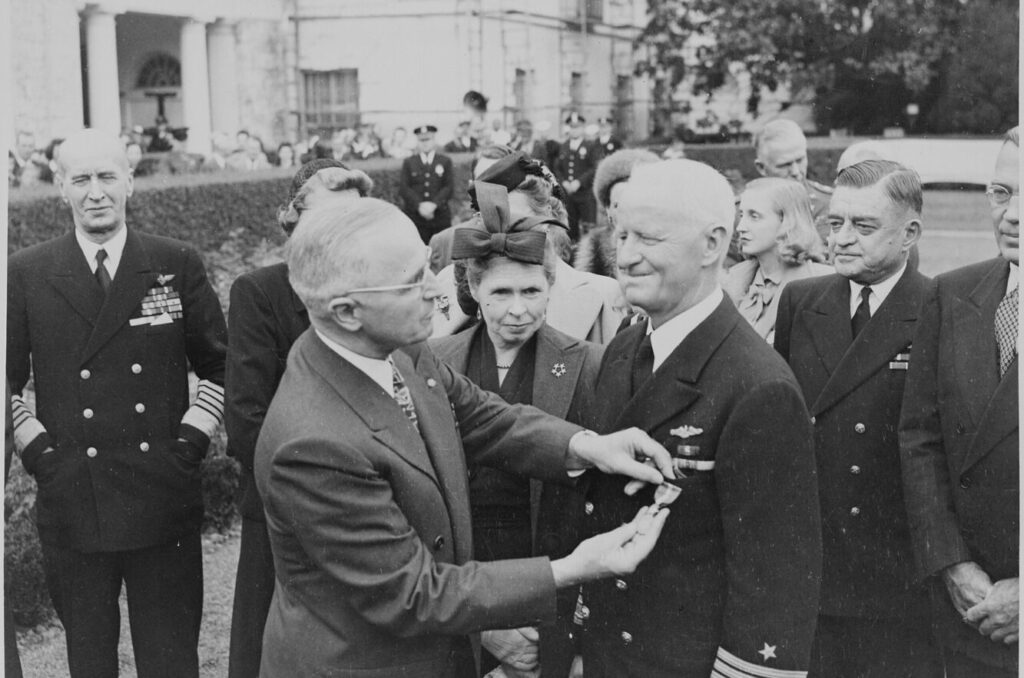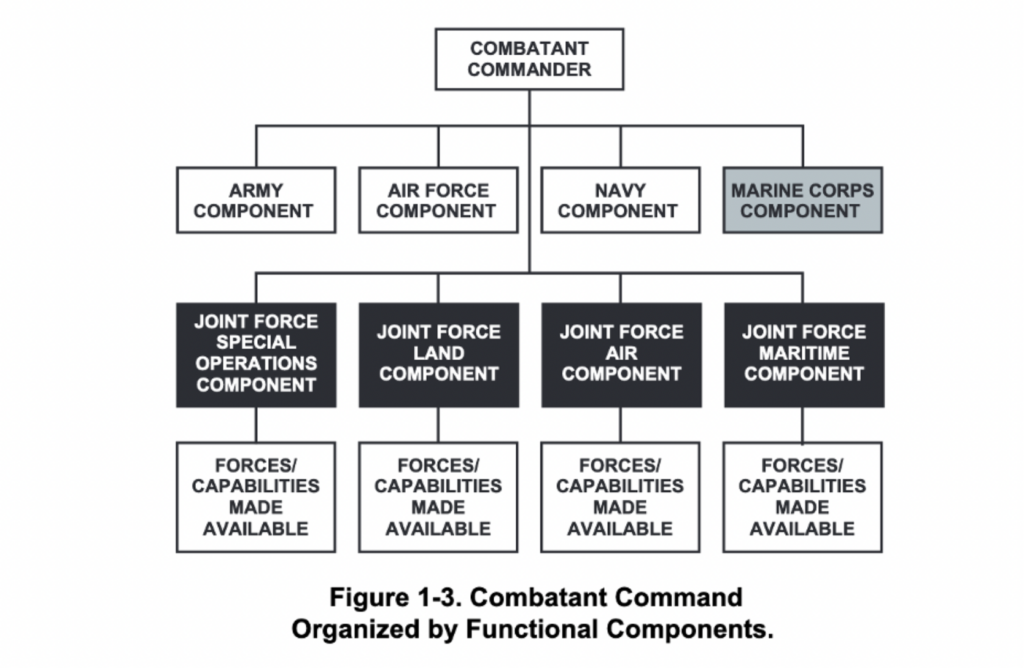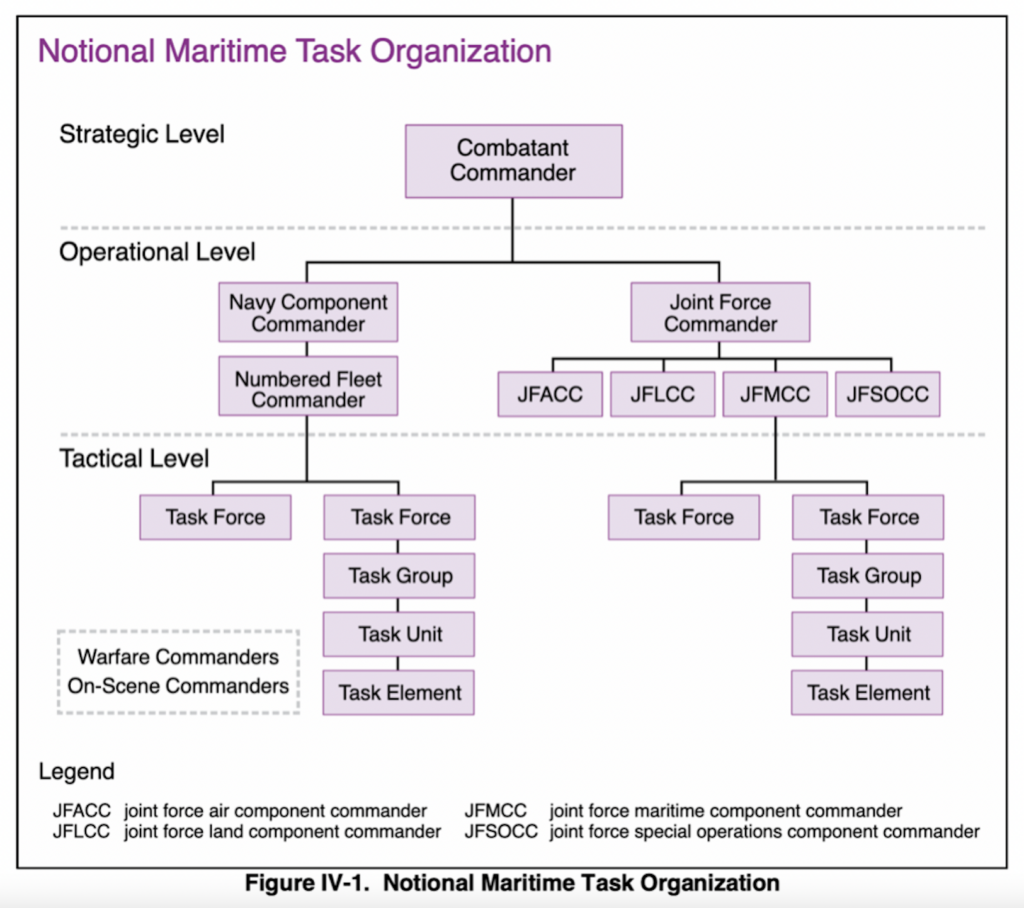Forging the Force: A Joint Task Force in the Indo-Pacific

Referring to the People’s Liberation Army, the commander of U.S. Indo-Pacific Command recently reported to Congress that “we haven’t faced a threat like this since World War II.” The nature of this threat should compel allied militaries to strengthen their efforts in the Indo-Pacific. One way to do so is by creating a standing joint task force headquarters. The 2023 National Defense Authorization Act directed the establishment of such a headquarters in the Indo-Pacific by 1 Oct. 2024, but congressional leaders have conveyed concern with U.S. Indo-Pacific Command’s current approach.
As civilian and military leaders explore options to meet the operational and congressional requirements for a joint task force, it is worth remembering the lessons of commanding and controlling air, land, and sea forces during America’s largest maritime campaign in history. In the Pacific War, Fleet Adm. Chester Nimitz and the U.S. Pacific Fleet staff rapidly adapted to the demands of the campaign and achieved tempo through the close cooperation of multiple staffs. Still, Nimitz was continually challenged by the span of control and responsibility levied upon his command. Although some of these challenges persisted throughout the war, U.S. Pacific Fleet ultimately formed an adaptive, innovative headquarters that relentlessly advanced on their adversary.
A contemporary joint task force headquarters in the Indo-Pacific can build upon these historical lessons by leveraging the teamwork between U.S. Pacific Fleet and U.S. Marine Corps Forces, Pacific, harnessing the unique capabilities of subordinate and adjacent component commands, and closely cooperating with allies on key terrain. Such a joint task force headquarters can effectively prosecute a predominantly maritime campaign in the competition phase and facilitate the rapid transition to conflict if necessary. Although the People’s Liberation Army may dictate the time and location of future aggressive actions, the U.S. joint force and allies can set the conditions now to rapidly adapt and seize the initiative from an authoritarian invading force.
Pervasive Challenges of Command and Control in the Pacific
As the fight progressed across the Western Pacific in the final years of World War II, the commander of U.S. Pacific Fleet faced the tensions of strategic, operational, and tactical responsibilities. Nimitz had to balance his proximity to the fight with relationships to higher headquarters and the necessity to coordinate administrative and logistics support in rear areas. These tensions exacted such a toll on Nimitz that close friends were “shocked at his physical condition,” which was characterized by insomnia and weight loss.
Nimitz was also challenged by the relentless, but ultimately advantageous, pace of Allied operations across the Pacific. Always conscious of the nation’s will to fight, Nimitz prioritized rebuilding morale through rapid, offensive action as an immediate objective after assuming command of U.S. Pacific Fleet. To this end, he was supremely successful. In the 38 months between February 1942 and April 1945, U.S. Pacific Fleet launched 22 battles and campaigns that destroyed Imperial Japanese forces and hastened a conclusion to the war.
One way that Nimitz maintained this tempo was through the employment of two commands and two staffs to fight a single force. He established Third Fleet, commanded by Adm. William “Bull” Halsey, and Fifth Fleet, commanded by Adm. Raymond Spruance, to fight the same maritime force — “Big Blue.” This command and control construct saw Nimitz employ one fleet in the fight while he supervised the planning of a subsequent campaign by another fleet headquarters. Through years of cultivating close cooperation amongst his team, Nimitz created this “vast and efficient organism” that promoted adaptability, fostered flexibility, and ultimately gained tempo over their adversary.
The employment of subordinate task forces in the fleets also yielded additional flexibility that was only possible through a common doctrine and deliberate training. Task Force 56, which commanded U.S. landing forces in multiple amphibious operations, significantly reduced the burden on senior commanders while maintaining unity of command within a maritime campaign. To further relieve Fleet Admiral Nimitz of the growing span of control required to command forces ashore and at sea, the Department of the Navy established Fleet Marine Force Pacific to command multiple corps-level Marine formations. The force’s first commander, Lt. Gen. Holland M. “Howlin’ Mad” Smith, fulfilled this operational role during the Battle of Iwo Jima, where he commanded three Marine divisions that comprised Task Force 56. These flexible, task-organized headquarters allowed fleet commanders and Nimitz to establish the requisite command and control necessary for a given mission.
Closer cooperation between services also alleviated these persistent command and control challenges. Through the subsequent Battle of Okinawa, the U.S. Army assumed a larger leadership role in the maritime campaign. Directly subordinate to Spruance and Fifth Fleet, U.S. Army Lt. Gen. Simon Buckner commanded the U.S. 10th Army, which consisted of a corps from the Army and a corps from the Marine Corps. This task organization harnessed the capabilities and expertise of land forces within a maritime campaign in the Pacific.
Considering these World War II command and control challenges, naval strategist Milan Vego observed that while “the Allies established a sound command structure in the Pacific theater,” Nimitz still “had too many responsibilities.” Accordingly, Vego recommended that “a theater commander should not overly centralize command and control by collecting too many responsibilities but should establish intermediate levels of command.” The Department of Defense’s contemporary doctrine, Joint Maritime Operations, captures these lessons from World War II and recommends that a maritime commander “focus attention on the operational level” and “delegate the authority to plan and execute tactical missions.”
The Navy and Marine Corps made momentous organizational changes in the Pacific to defeat a peer threat in World War II. These changes alleviated the burden of operational and tactical responsibilities on the commander, while unleashing the potential of subordinate commanders through flexible task organization. The type of interservice cooperation employed by the end of World War II also set the foundation for institutional changes that established a more effective joint task force, and that endure to this day.
A Joint Force in a Maritime Campaign
Following the 1986 Goldwater-Nichols Act, the establishment of a theater-wide combatant commander, and the subordination of service components to the joint force commander, new opportunities exist to unleash the full potential of subordinate commands in both competition and, potentially, conflict. These subordinate commands can form the core of a joint task force that focuses on operational and tactical problems, thus freeing the joint force commander to focus on strategic and interagency integration. As in World War II, the Navy and Marine Corps team remains the optimal force around which to rapidly build a joint task force in the Indo-Pacific.
U.S. Indo-Pacific Command’s modern-day Navy and Marine Corps team is a formidable power of approximately 233,000 personnel, 2,140 aircraft, and 200 ships that constitute most of the joint force in the Indo-Pacific. Collectively, this maritime team possesses operational control of two numbered fleets and two Marine Expeditionary Forces. Seventh Fleetand Third Fleet operate west and east of the International Date Line, respectively, while I Marine Expeditionary Force and III Marine Expeditionary Force are persistently postured alongside Taiwan and are increasingly employing capabilities to affect a maritime campaign. While “Howlin’ Mad” Smith never attained operational command of two corps-sized Marine formations during World War II, his modern-day successor at U.S. Marine Corps Forces, Pacific, now commands and controls two such forces every day.
Although the combatant commander now relieves contemporary component commanders of the primary responsibilities for strategic planning, the span of control for a prospective joint task force commander in the Indo-Pacific far exceeds that in World War II. A former U.S. Indo-Pacific commander framed his area of responsibility as everything from “Hollywood to Bollywood, polar bears to penguins,” including half of the world’s population. Regardless of the boundaries that may be established for a joint task force, component commanders will also likely retain functional responsibilities across the theater — for example, U.S. Pacific Fleet headquarters might form the core of the theater joint force maritime component command, and U.S. Army Pacific headquarters might form the theater joint force land component command. Additionally, component commanders retain their Title 10 responsibilities to man, train, and equip their assigned forces in much the same way as Nimitz and Smith did in World War II.

Service components and functional components — such as land, air, maritime, and special operations — are several ways in which a geographic combatant commander can organize headquarters and assigned forces.
Two Commanders, Two Staffs, One Team
As in World War II, increased cooperation between the services can relieve the burden on the joint force commander. U.S. Pacific Fleet simultaneously manages theater responsibilities, competition, regional crises, and preparedness for conflict, and a distinct and deployable maritime commander and staff would allow U.S. Indo-Pacific Command to manage multiple competing demands and to focus on the threat. The commander and staff of U.S. Marine Corps Forces, Pacific, offer the potential to serve as the cadre of such a joint headquarters in a maritime campaign.
With increased interoperability between Navy and Marine Corps staffs, the joint task force commander possesses the capability to task-organize two separate but unified commands to simultaneously focus on multiple complex and interrelated problems. Just as Third Fleet and Fifth Fleet alternated between planning and executing operations in World War II, the joint task force commander can now assign highly interoperable Navy and Marine Corps staffs to emerging requirements, thus maintaining a relative tempo advantage over more centralized challengers.
Marine Corps Warfighting Publication 7-10, Marine Corps Componency, describes this command and control arrangement as “two commanders and two staffs.” With two commanders, two staffs, and one direction undertaken through a single force, a prospective joint task force commander “allows each commander and staff to maintain a single, focused orientation” while allowing commanders to “place himself/herself at the appropriate location.” This employment model was demonstrated in the aftermath of the Sept. 11 attacks, when the Marine Corps component headquarters deployed to Bahrain and served as the service component for U.S. Central Command (Forward) and a combined joint task force.
Wallace “Chip” Gregson, a former assistant secretary of defense for Asian and Pacific security affairs and commander of U.S. Marine Corps Forces, Pacific, previously advocated for the establishment of a standing combined joint task forcewith Japan that leveraged the forward-deployed Navy and Marine Corps team. Gregson argued that forward-deployed commands — such as Seventh Fleet, III Marine Expeditionary Force, or I Marine Expeditionary Force — could comprise the nucleus of a joint task force. Furthermore, integrated Navy and Marine Corps commands at multiple echelons provide scalable options to form a joint task force headquarters. Task Force 76/3, an integrated one-star command, all the way up to U.S. Marine Corps Forces, Pacific, are well positioned to serve as the forward command element for a standing joint task force led by U.S. Pacific Fleet.

The task force construct established in World War II can also be applied to a joint task force prosecuting a maritime campaign.
A Combined Arms Team from Creation
All-domain expertise and capabilities are critical for a joint task force operating in the Indo-Pacific, and the Navy–Marine Corps team is best suited to rapidly form the cadre of such a joint force. Marines and sailors have complemented each other with combined arms since the age of sail, and this mutually supporting relationship is as important as ever at the operational level. As Capt. Wayne P. Hughes, Jr., U.S. Navy (ret.), observed:
Maritime operations now must take account of more land-based forces and the sensors they employ; indeed, sea-based forces often must team with land-based forces that are located in friendly territory. Effective cooperation — in joint and combined operations, both operational and tactical, is a modern-day imperative.
Navy and Marine Corps component headquarters can cross-attach subject matter experts to form the cadre of a deployable joint task force headquarters while maintaining theater functional and service components to exercise Title 10 responsibilities. In addition to the areas of expertise often associated with the Marine Corps, such as ground combat and amphibious operations, Marines can provide expertise in all-domain command and control, regional air defense, fires, and effects. These skill sets diversify and increase the capabilities of a combined arms team and better prime a maritime staff’s potential transition to a joint task force.
While maritime forces are capable of proficient planning in many warfighting areas, joint forces are essential to building expertise in all critical missions. U.S. Army Pacific brings expertise in sustainment and integrated air and missile defense, while Pacific Air Force can provide theater air defense expertise and a conduit to strategic forces. Together, a joint task force in the Indo-Pacific can leverage U.S. proficiency in combined and joint operations to perpetuate an asymmetric deterrent effect against the People’s Liberation Army.
These areas of expertise are amplified when considering regional relationships with foreign military services. Hughes also noted in Fleet Tactics and Naval Operations that “the Navy must plan its operations or battles in littoral waters with an eye towards cooperation and sometimes close coordination with the armed forces of the country that it is trying to support.” Land forces of allies and partners in the first island chain play a critical role in maritime defense across the spectrum of conflict, and both soldiers and marines can serve as interlocuters with these forces on key terrain. The relationship between the U.S. Marine Corps and the Philippine Marine Corps, for example, provides a basis for planning and coordinating a maritime campaign on key terrain. Additionally, the longstanding service relationships between the Australian Army, Japan Ground Self-Defense Force, U.S. Army, and U.S. Marine Corps provide a joint headquarters with vital cross-domain linkages to key allies in the region.
These linkages are even more critical as key allies field maritime-focused capabilities, establish new organizations, and increasingly align activities accordingly. The Philippine Marine Corps established its coastal defense regiment in 2021, and the Philippine Army also plans to acquire anti-ship missiles for its artillery regiment. Marines and soldiers from the Philippines and United States are regularly training together on these emerging concepts and capabilities, and greater coordination and planning at higher echelons will accelerate the development of these critical capabilities. These efforts parallel work with the Australian Army’s littoral-focused 1st Brigade and the Japan Ground Self-Defense Force’s Amphibious Rapid Deployment Brigade. At the operational level, a U.S. joint task force offers the potential to better unify these critical efforts across the Pacific with allied counterparts such as Japan’s recently established joint operational command and Australia’s Headquarters Joint Operations Command.
Preparing for an Uncertain Future
Although the means have changed, many of the lessons from World War II in the Pacific remain relevant to a joint force today. Whereas Third Fleet and Fifth Fleet rotated between campaigns in World War II, today the staffs of U.S. Pacific Fleet and U.S. Marine Corps Forces, Pacific, can relentlessly campaign against the People’s Liberation Army. And while the Army and Navy only integrated at the operational level in the final days of World War II, today the joint force could deliberately incorporate joint capabilities in a campaign to maintain a free and open Indo-Pacific.
While the division of command and control between the Army and Navy in the Pacific during World War II at times presented evidence to the contrary, no one service can compete or fight effectively alone in the Indo-Pacific. While the Navy and Marine Corps team can rapidly establish the cadre of a joint task force headquarters within the congressionally mandated timeline, further deliberate planning is vital to harness the full capabilities of all services in a standing joint task force. Although 2027 is rapidly approaching, the U.S. joint force can forge a force that will relentlessly campaign against the looming threat and defend allies and partners from invasion.
Lieutenant Colonel Zach Ota is an infantry officer and international affairs officer in the United States Marine Corps. He currently serves as a planner for U.S. Pacific Fleet and U.S. Marine Corps Forces, Pacific. The views expressed in this article do not necessarily reflect the positions of the Department of Defense or the United States Marine Corps.
Image: Wikimedia

